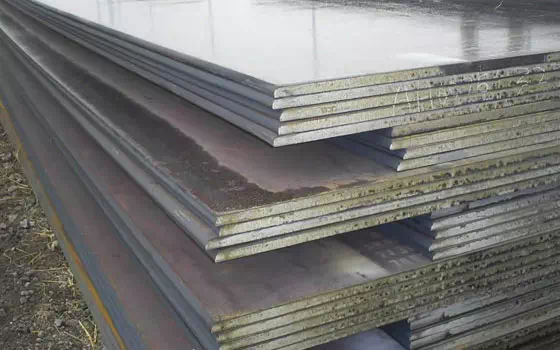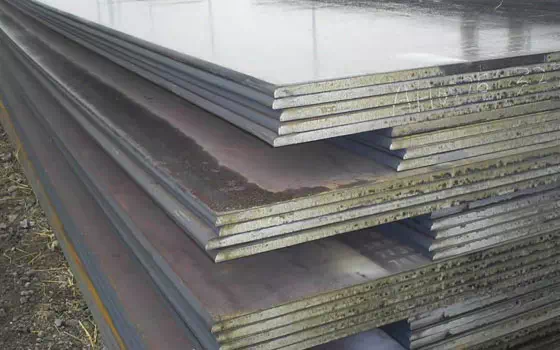Welcome to Zhishang Steel Co., Ltd.
TEL: (Gavin) +86-15665898999 | Email : info@zhishangsteel.com
Location:Home>>News>>Company News » Carbon structural steel

Carbon structural steel, a carbon steel. Carbon content of about 0.05% ~ 0.70%, individual can be as high as 0.90%. Can be divided into ordinary carbon structural steel and high-quality carbon structural steel two categories. Many uses, the amount is large, mainly used in railway, bridge, all kinds of construction projects, the manufacture of various metal components under static load and not important mechanical parts and general welding parts that do not need heat treatment.
A type of carbon steel. Carbon content of about 0.05% ~ 0.70%, individual can be as high as 0.90%. Can be divided into ordinary carbon structural steel and high-quality carbon structural steel two categories. The former contains more impurities, low price, used in places where the performance requirements are not high, its carbon content is mostly below 0.30%, the manganese content does not exceed 0.80%, the strength is low, but the plasticity, toughness, cold deformation performance is good. Except for a few cases, it is generally not used for heat treatment and is used directly. Made of strip steel, special-shaped steel, steel plate and so on. Many uses, the amount is large, mainly used in railway, bridge, all kinds of construction projects, the manufacture of various metal components under static load and not important mechanical parts and general welding parts that do not need heat treatment. High-quality carbon structural steel is pure, less impurities, good mechanical properties, and can be used after heat treatment. According to the manganese content, it was divided into two groups: common manganese content (less than 0.80%) and high manganese content (0.80% ~ 1.20%). The carbon content is less than 0.25%, most of them are used directly without heat treatment, or are treated by carburizing, carbonitriding, etc., to manufacture small and medium-sized gears, shafts, piston pins, etc.; Carbon content in 0.25% ~ 0.60%, typical steel numbers are 40, 45, 40Mn, 45Mn, etc., after tempering treatment, manufacturing a variety of mechanical parts and fasteners; Carbon content of more than 0.60%, such as 65,70,85,65 Mn, 70Mn, etc., mostly used as spring steel.

Carbon steel can be divided into low carbon steel, medium carbon steel and high carbon steel according to its chemical composition (that is, carbon content).
(1) Low carbon steel, also known as mild steel, carbon content from 0.10% to 0.25% Low carbon steel easy to accept a variety of processing such as forging, welding and cutting, often used in the manufacture of chains, rivets, bolts, shafts and so on.
(2) Carbon steel carbon content 0.25% ~ 0.60% carbon steel. There are many kinds of products such as killed steel, semi-killed steel and boiling steel. In addition to carbon, it can also contain a small amount of manganese (0.70% ~ 1.20%). According to product quality, it is divided into ordinary carbon structural steel and high-quality carbon structural steel. Hot working and cutting performance is good, but welding performance is poor. The strength and hardness are higher than low carbon steel, while the plasticity and toughness are lower than low carbon steel. Hot-rolled and cold-drawn materials can be used directly without heat treatment, and can also be used after heat treatment. The medium carbon steel after quenching and tempering has good comprehensive mechanical properties. The highest hardness that can be achieved is about HRC55(HB538), σb is 600 ~ 1100MPa. Therefore, in the various uses of medium strength level, medium carbon steel is the most widely used, in addition to as a building material, but also a large number of used in the manufacture of various mechanical parts.
(3) High carbon steel is often called tool steel, carbon content from 0.60% to 1.70%, can be hardened and tempered. Hammers, crowbars, etc. are made of steel with a carbon content of 0.75%; Cutting tools such as drills, taps, reamers, etc. are manufactured from steel with a carbon content of 0.90% to 1.00%.
According to the quality of steel can be divided into ordinary carbon steel and high-quality carbon steel.
(1) Ordinary carbon structural steel, also known as ordinary carbon steel, has wider restrictions on carbon content, performance range and phosphorus, sulfur and other residual element content. In China and some countries, it is divided into three categories according to the guarantee conditions of delivery: Class A steel (Class A steel) is a steel that guarantees mechanical properties. Class B steel (Class B steel) is the steel that guarantees the chemical composition. Special steel (Class C steel) is a steel that guarantees both mechanical properties and chemical composition, and is often used to manufacture more important structural parts. China currently produces and uses the most A3 steel (Class A No. 3 steel) with carbon content of about 0.20%, which is mainly used for engineering structures. Some carbon structural steels also add trace amounts of aluminum or niobium (or other carbide forming elements) to form nitrides or carbide particles to limit grain growth, strengthen steel and save steel. In China and some countries, in order to meet the special requirements of professional steel, the chemical composition and properties of ordinary carbon structural steel are adjusted, and a series of ordinary carbon structural steel professional steel (such as bridge, construction, rebar, pressure vessel steel, etc.) has been developed.
(2) Compared with ordinary carbon structural steel, the content of sulfur, phosphorus and other non-metallic inclusions is lower. According to the different carbon content and use, this type of steel is roughly divided into three categories:
① less than 0.25%C is low carbon steel, especially with carbon content of less than 0.10% of 08F,08Al, etc., because of its good deep drawing and weldability and is widely used as deep drawing parts such as automobiles, canning... Let's wait. 20G is the main material for making ordinary boilers. In addition, low carbon steel is also widely used as carburizing steel for machinery manufacturing.
②0.25 ~ 0.60%C is medium carbon steel, which is mostly used in the tempered state to make parts of the machinery manufacturing industry.
③ More than 0.6%C is high carbon steel, which is mostly used in the manufacture of springs, gears, rolls, etc. According to the different manganese content, it can be divided into ordinary manganese content (0.25 ~ 0.8%) and high manganese content (0.7 ~ 1.0% and 0.9 ~ 1.2%) two steel groups. Manganese can improve the hardenability of steel, strengthen ferrite, and improve the yield strength, tensile strength and wear resistance of steel. It is usually marked "Mn" after the grade of steel with high manganese content, such as 15Mn, 20Mn to distinguish it from carbon steel with normal manganese content.
According to the use, it can be divided into carbon structural steel and carbon tool steel. The carbon content of carbon tool steel is between 0.65 and 1.35%, and after heat treatment, high hardness and high wear resistance can be obtained, mainly used in the manufacture of various tools, cutting tools, molds and measuring tools (see tool steel). Carbon structural steel is divided into four grades according to the yield strength of steel: Q195, Q215, Q235, Q275 each grade is divided into A, B, C, D grades due to different quality, there are four at most, and some only one; There are also differences in the deoxidation methods of steel smelting. Deoxidation method symbol: F -- boiling steel Z -- killing steel TZ -- special killing steel
Mechanical property
This kind of steel mainly guarantees mechanical properties, so its grade reflects its mechanical properties, expressed by Q+ numbers, where "Q" is the Chinese pinyin prefix of the yield point "Qu" word, the number indicates the yield point value, such as Q275 indicates that the yield point is 275Mpa. If the letters A, B, C, D are marked after the grade, it means that the quality of steel is different, the amount of S and P is reduced in turn, and the quality of steel is increased in turn. If the letter "F" is marked after the grade, it is boiling steel, the mark "b" is semi-killed steel, and the one who does not mark "F" or "b" is killed steel. For example, Q235-A·F indicates grade A boiling steel with a yield point of 235Mpa, and Q235-C indicates Grade C killed steel or special killed steel with a yield point of 235Mpa.
Mass fraction
Carbon structural steel is generally not heat treated, but directly used in the supply state. Usually Q195, Q215, Q235 steel carbon mass fraction is low, good welding performance, plasticity, toughness, has a certain strength, often rolled into sheet, steel bar, welded steel pipe, etc., used in Bridges, buildings and other structures and the manufacture of ordinary screws, nuts and other parts. Q255 and Q275 steel carbon mass fraction is slightly higher, higher strength, plasticity, toughness, can be welded, usually rolled into steel, strip steel and steel plate as structural parts and the manufacture of simple mechanical connecting rod, gear, coupling, pin and other parts.
Representation method
The grade of carbon structural steel is composed of four parts in order, such as the letter representing the yield point, the value of the yield point, the quality grade symbol, and the deoxidation method symbol.
For example, Q235-A·F indicates grade A boiling steel with a yield point of 235Mpa, and Q235-C indicates grade C sedative steel with a yield point of 235Mpa. Carbon structural steel is generally not heat treated and is used directly in the supply state.

Zhishang Steel has always been a pioneer in custom steel and special supplies, and has been recognized for its efforts in enhancing work efficiency and product quality. In addition to ISO9001:2015 certification, we also adhere to strict quality policies and proprietary procedures. If you have any questions, please contact us to provide the best type of product solution for your pre-painted, coil coating metal process, we will closely support after-sales service to ensure that your subsequent problems can be solved in a timely manner, if you have any questions, please send email to info@zhishangsteel.com, we look forward to serving you.

Zhishang Steel, specializing in domestic steel products trade, warehousing, processing and other services. The team has four service teams: Shandong Zhishang Steel Co., LTD., Shandong Zhiyiheng Trading Co., LTD., Tai 'an Zhishang Economic and Trade Co., LTD., Shandong Zhishang Steel Structure Co., LTD. Mainly engaged in steel coil, coated, stee···